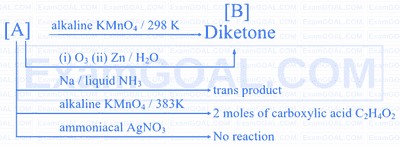Hydrocarbons · Chemistry · COMEDK
MCQ (Single Correct Answer)
What would be the major product formed in the reaction?

Consider the following reaction
$$\text { Propyne }+\mathrm{CH}_3 \mathrm{MgBr} \xrightarrow{\text { dry ether }} \mathbf{X}$$
Identify ' X ' from the following.
Identify the type of reaction:

Identify the Carbonyl compound which will not be formed when hydration of Alkynes is carried out with dil. $\mathrm{H}_2 \mathrm{SO}_4 / \mathrm{Hg}^{2+}$ at 333 K .
Acetone, Butanal, Ethanal, Butanone.
Match the reactions in Column I with the correct products given in Column II
| S.No. | Column I | S.NO. | Column II |
|---|---|---|---|
| A. | 1- Chloropropane $+(\mathrm{Zn} / \mathrm{HCl}) \rightarrow$ | P. | Propanone + Methanal |
| B. | n- Hexane $+\left(\right.$ anh. $\left.\mathrm{AlCl}_3 / \mathrm{HCl}_{(\mathrm{g})}\right) \rightarrow$ | Q. | Propanone |
| C. | 2- Methylpropene $+\left(\mathrm{O}_3 \& \mathrm{Zn} / \mathrm{H}_2 \mathrm{O}\right) \rightarrow$ | R. | Propane |
| D. | Propyne $+\left(\mathrm{HgSO}_4 / \mathrm{H}_2 \mathrm{SO}_4\right.$ at 333 K$) \rightarrow$ | S. | 2-Methylpentane + 3-Methylpentane |
An unsaturated hydrocarbon $[\mathrm{A}]$ undergoes the following series of reactions. Identify $[\mathrm{A}]$.

A Hydrocarbon [A] (molecular formula $$\mathrm{C}_3 \mathrm{H}_6$$) on reaction with $$\mathrm{Br}_2 / \mathrm{CCl}_4$$ gave [B]. When [B] is heated with 2 moles of alcoholic $$\mathrm{KOH}$$, it gave compound [C]. 3 moles of Compound [C] when passed through red hot Iron tube forms [D]. Identify [D].
Identify the product $$[\mathrm{C}]$$ formed at the end of the reaction below
1,1,2,2- Tetrabromopropane + 2 $$\mathrm{Zn}_{(\mathrm{S})}$$ / Ethanol $$\rightarrow$$ [B]
$$[\mathrm{B}]$$ + 2 moles of $$\mathrm{HBr} \rightarrow[\mathrm{C}]$$
Given below are 4 reactions. Two of these reactions will give product which is an equimolar mixture of the d and 1 forms. Identify these 2 reactions.
[A] 2- Methylpropene + $$\mathrm{HI} \rightarrow$$ ---------
[B] But-1-ene + $$\mathrm{HBr} \rightarrow$$ -----------
[C] 3-Methylbut-1-ene + $$\mathrm{HI} \rightarrow$$ -----------
[D] 3- Phenylpropene + $$\mathrm{HBr}$$ (Peroxide) $$\rightarrow$$ -----------
Which of the following reactions is an example for incomplete combustion?
An unsaturated hydrocarbon $$[\mathrm{A}]$$ reacts with $$\mathrm{HBr}$$ in presence of Benzoyl peroxide to yield [B] Compound [A] when reacted with cold, dilute alkaline $$\mathrm{KMnO}_4$$ gave compound [C], 2-Methylbutane-2, 3-diol But when [A] is reacted with hot $$\mathrm{KMnO}_4$$, it yielded $$\mathrm{CH}_3 \mathrm{COOH}$$ and a compound [D] Identify compounds [A], [B] and [D]
An aromatic hydrocarbon $$[\mathrm{A}]\left(\mathrm{Molecular}\right.$$ formula $$\left.\mathrm{C}_9 \mathrm{H}_{12}\right)$$, undergoes air oxidation followed by reaction with dil. $$\mathrm{HCl}$$ to give [B] as one of the products
Compound [B] forms a white precipitate on treatment with $$\mathrm{Br}_2(\mathrm{aq})$$
Sodium salt of [B] reacts with $$\mathrm{CO}_2$$ at $$400 \mathrm{~K}$$ under high pressure followed by acid hydrolysis to give [C]
Compound [C] reacts with acetic anhydride / conc. $$\mathrm{H}_2 \mathrm{SO}_4$$ to form [D] Identify compound $$[\mathrm{D}]$$
Ammoniacal silver nitrate forms a white precipitate easily with
The conversion of Propyne to Benzene can be brought out in 4 steps.
Choose the reagents to be used, in the proper sequential order, to bring out the conversion.
Reagents provided: alc. $$\mathrm{KOH}, \mathrm{H}_2 / \mathrm{Pd}, \mathrm{Na} /$$ dry ether, $$\mathrm{HBr}, \mathrm{HBr} /\left(\mathrm{C}_6 \mathrm{H}_5 \mathrm{CO}\right)_2 \mathrm{O}_2$$, Soda-lime, $$\mathrm{Cr}_2 \mathrm{O}_3$$ (high T and P), Conc. $$\mathrm{H}_2 \mathrm{SO}_4$$
Identify the reagents $$\mathrm{X}, \mathrm{Y}$$ and $$\mathrm{Z}$$ used to bring out the following reactions.

What can be A and B in the following reaction?

Which of the product is not possible in Wurtz reaction?
Coupling reaction is an example of
The hydrocarbon that cannot be prepared effectively by Wurtz reaction
What is the product formed when benzene react with CO and HCl in presence of anhydrous AlCl$$_3$$?
The general formula of a cycloalkene is
According to Baeyer's strain theory which is highly stable?